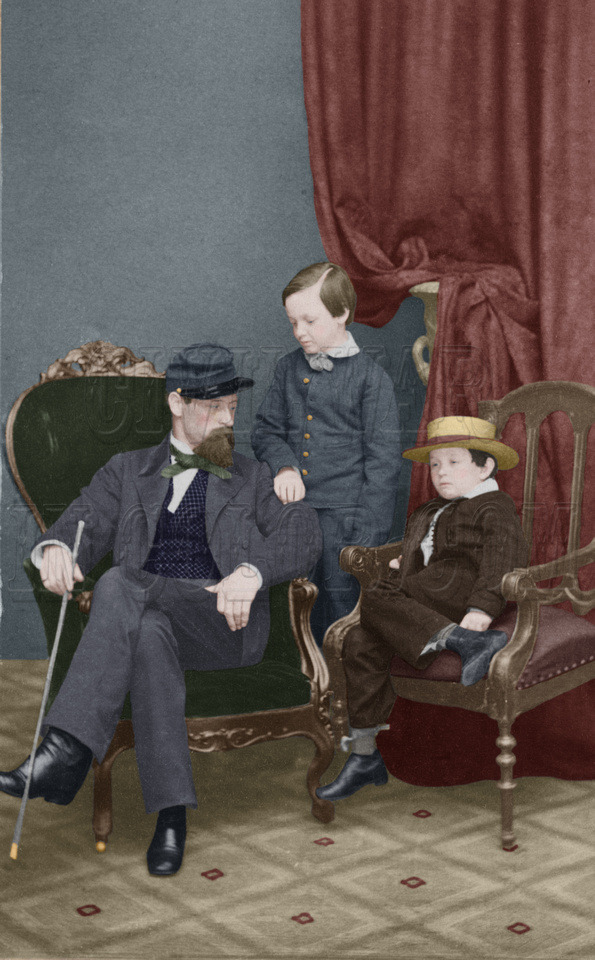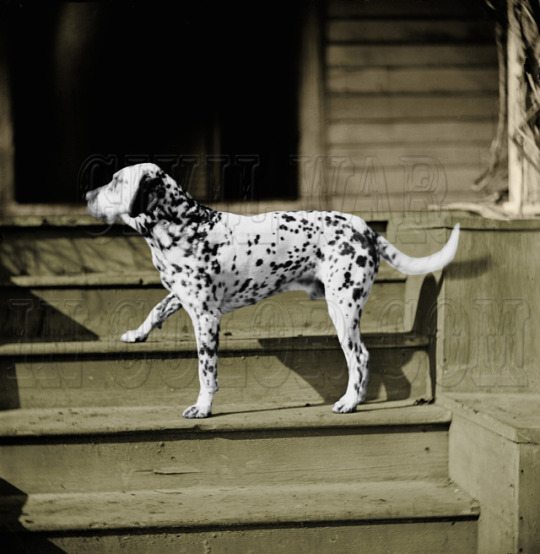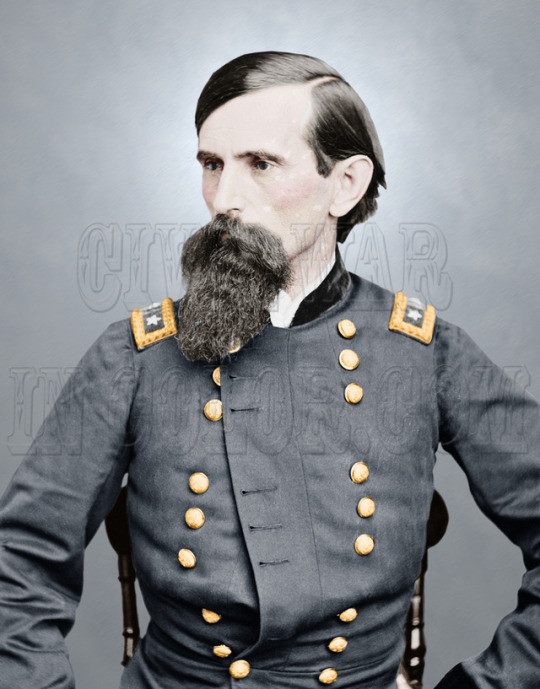#civilwarphoto
Explore tagged Tumblr posts
Text
@daguerreotyping Thanks to the wonders of modern facial recognition tech, it appears he's been identified! His name was Charles P. Drew, he was a native of Ontario, Canada, and he served in the 11th Kansas Infantry/Cavalry from 1862-1865. You'll be relieved to know he survived the war and lived to the age of 72.


The ID was made via CivilWarPhoto sleuth: https://www.civilwarphotosleuth.com/photos/view/61401/ Biographical info via Findagrave: https://www.findagrave.com/memorial/18909099/charles_pate-drew

Carte de visite of a dashing young Union soldier with pomade in his hair and worry in his eyes, c. 1861-65
355 notes
·
View notes
Photo

Firing a Quaker Gun, Centreville, VA 1862
"[I]t was a favorite trick to run it out into the center of the road and go through the motions of loading a gun and pointing it at the enemy, who promptly stampeded, under the impression that we had a piece of artillery with us" - PVT Edgar Warfield, 17th Va., Munson's Hill, Va.
"Quaker Guns" - logs, usually painted black, have been used to deceive the enemy in North America since the American Revolution. Adding wheels to the log, made it virtually impossible to discern it was a fake from a distance. During the Civil War, both sides, including civilians would hoodwink their foe using logs, stove-pipes, kegs and more.
After the First Battle of Manassas, Va. on July 21, 1861, Col. J.E.B. Stuart's troops ended up approximately six miles from Washington D.C. at Munson's Hill, Va.. While Gen. Joseph Johnston reorganized the Confederate Army of the Potomac, Stuart dug earthworks that appeared to be up to 15' high and erected signal stations. Lacking actual cannons, he placed Quaker Guns in the trenches.
As Gen. James Longstreet later recalled, "the authorities allowed me but one battery. . . we collected a number of old wagon-wheels and mounted on them stove-pipes of different calibre, till we had formidable-looking batteries, some large enough of calibre to threaten Alexandria, and even the National Capitol and Executive Mansion."
For the next two months, Gen. George McClellan drilled the Army of the Potomac at the capital. Thaddeus Lowe would send up his observation balloons to check out the situation. Stuart was promoted to the rank of Brig. General. The Confederates kept busy firing at anyone approaching on the broad, flat plain called Bailey's Crossings below and the observation balloons above.
As there weren’t any major battles being fought, the newspapers focused on the Confederates above Washington, who alarmed everyone living at the capital by flying "an immense Confederate flag—the red, white, and blue stripes in which are at least five feet wide each—is the most prominent object upon the top of the eminence." According to the New York Times, it "was visible with a glass from the top of the shiphouse at the Navy-yard" in Washington D.C..
Longstreet recollected, "[w]e were provokingly near Washington, with orders not to attempt to advance even to Alexandria." Johnson on the other hand considered the Munson's Hill position as defensively unsound and logistically difficult to keep supplied. McClellan, by twice sending out heavy armed reconnaissance parties to probe the rebel lines, may have convinced Johnson that enough was enough. It was time for the troops to fall back.
On September 28, 1861, the Confederates abandoned Munson's Hill, leaving behind their Quaker Guns. After having been terrified by logs, the North proceed to mock the army in the newspapers and by song. McClellan was the target of "The Bold Engineer" and the situation was declared a "humbug - worse that a Bull-run" in the song, "The Battle of the Stoves-Pipes". However, as the war proceeded, the newspapers began to defend the generals by pointing out that without risking being fired upon, it is difficult to discern logs from actual cannons.
#quakergun#munsonhill#civilwargeneral#genjebstuart#genlongstreet#genjoejohnston#genjohnston#genMcClellan#thadduslowe#historyinfullcolor#historyincolor#civilwarincolor#civilwarcolorphoto#civilwarphoto
2 notes
·
View notes
Text

Photograph of Store for Freedmen in Beaufort, South Carolina
Series: 19th Century Mathew Brady, Quartermaster, and Other Civil War Photographs, ca. 1875 - 1941 Record Group 165: Records of the War Department General and Special Staffs, 1860 - 1952
War Department. General Staff. 8/15/1903-9/18/1947 (Most Recent) War Department. Office of the Chief Signal Officer. (8/1/1866 - 9/18/1947) (Predecessor)
National Archives Identifier: 593457
Local Identifier: 165-C-393
1 note
·
View note
Photo

#GettysburgPennsylvania #ConfederatePrisoners #PrisonersOfWar #Andersonville #Libbyville #ConfederatePrisonCamps #UnionPrisonCamps #WarCrimes #WarCriminals #AmericanCivilWar #WarBetweenTheStates #BattleOfGettysburg #CivilWarPhotos #ConfederateStatesOfAmerica #ConfederateArmyOfNorthernVirginia #HethsDivision #HarryHeth https://www.instagram.com/p/CcNC0jprJUYx67L02CtMN0ojZ4s0gzWZErwBFg0/?igshid=NGJjMDIxMWI=
#gettysburgpennsylvania#confederateprisoners#prisonersofwar#andersonville#libbyville#confederateprisoncamps#unionprisoncamps#warcrimes#warcriminals#americancivilwar#warbetweenthestates#battleofgettysburg#civilwarphotos#confederatestatesofamerica#confederatearmyofnorthernvirginia#hethsdivision#harryheth
0 notes
Photo

MATTHEW B. BRADY en 1862 documento la Guerra Civil estadounidense con un gran equipo de fotógrafos. Instagram @fotografos_master #matthewbbrady #civilwar #civilwarhistory #civilwarhistory #abrahamlincoln #abrahamlincolnphotography #civilwarphotography #civilwarphotos #bnwphotography #bwphotography #blackandwhite #blackandwhitephotography #photohistory #photographyhistory #knowfacts #facts #filmhistory #war #northandsouth #americanwar (at Washington DC, USA) https://www.instagram.com/p/CE_Jk2tjRkp/?igshid=954bl01si9lb
#matthewbbrady#civilwar#civilwarhistory#abrahamlincoln#abrahamlincolnphotography#civilwarphotography#civilwarphotos#bnwphotography#bwphotography#blackandwhite#blackandwhitephotography#photohistory#photographyhistory#knowfacts#facts#filmhistory#war#northandsouth#americanwar
0 notes
Photo

I would like to thank #LisaKerchner for these #CivilWarPhotos. It helps bring #HistoryToLife #Vero #HistoricalOnVero #CivilWarHistorians https://www.instagram.com/p/B-MTLcaDY5y/?igshid=1msximnxe8lku
0 notes
Photo

U.S. Gen. Strong Vincent
“What death more glorious can any man desire than to die on the soil of old Pennsylvania fighting for that flag?” – Col. Strong Vincent On July 2, 1863, near the George Weikert house on Cemetery Ridge, U.S. Col Strong Vincent, was waiting at the head of the 3rd brigade, 1st division, during the second day of the Battle of Gettysburg, Penn. Noticing U.S. Gen George Sykes’ aide, Vincent rode forward asking, "Captain, what are your orders?" The captain replied, "Where is General [James] Barnes?" Vincent said, "What are your orders? Give me your orders" The captain answered, “General [George] Sykes told me to direct General Barnes to send one of his brigades to occupy that hill yonder,” pointing to Little Round Top. Vincent said, "I will take the responsibility of taking my brigade there." Although a lawyer in civilian life, Vincent knew to position his men not on top of the summit but on the crest below. As the battle raged below at Devil’s Den, Vincent concluded the top priority was to defend the western and southern slopes. He selected a ledge, known afterwards as Vincent’s Spur, as the spot to place his men. Shells began exploding on either side of Vincent and Pvt. Oliver Norton, who bore the brigade headquarters flag. “They are firing at the flag, go behind the rocks with it,” yelled Vincent. As the Confederates approached from the woods, Vincent gave instructions and encouragement as he positioned the 44th N.Y., 83rd Penn., 20th Maine and the 16th Mich. Col. Joshua Chamberlain, 20th Maine, was told, “this is the extreme left of our general line” which he was to “hold that ground at all hazards.” The right flank came under assault from the 4th Ala., 4th and 5th Texas. From the Spur “… a sheet of smoke and flames burst from our whole line.” Dead and wounded attackers tumbled intertwined downhill. “Now it was expected that our men having tried it and seeing the impossibility of taking the place would have refused to go in again”, recalled a 5th Texas soldier. “But no, they tried it a second time”. From the summit, U.S. Gen. Gouverneur Warren spotted a 5th Corps column passing below. Riding down to intercept it, Warren recognized the man at its head, Col Patrick O’Rourke, 140th N.Y. “Paddy, give me a regiment”, Warren said. O’Rourke protested that U.S. Gen. Stephen Weed, 3rd brigade, 2nd Division, expected him elsewhere. “Never mind that,” Warren interjected. “Bring your regiment up here and I will take the responsibility.” On the far right, mistakenly believing a retreat had been ordered, a third of the 16th Mich. followed its flag towards the rear. The rebels surged towards the collapsing line. Vincent waving his riding crop, leaped onto a rocky perch yelling, “Don’t give an inch boys. Don’t give an inch!” Vincent dropped, shot in the thigh, mortally wounded. Into the breech arrived the 140th, with unloaded guns. “No time now, Paddy, for alignment,” Warren shouted. “Take your men immediately into action.” O’Rourke ran forward. “Here they are men”, he yelled. “Commence firing.” The lines erupted as both sides obeyed. O’Rourke was mortally shot in the neck as his men rushed forward, energizing the entire federal line. The fight ended with the 20th Maine’s Col. Joshua Chamberlain leading the charge to drive the confederates off Little Round top. On the evening of July 2nd, U.S. Maj. Gen. George Meade recommended the promotion of Vincent to Brigadier General. His commission was read to him on his deathbed.
Previously, Vincent had written to his wife, "If I fall, remember you have given your husband to the most righteous cause that ever widowed a woman."
#Vincentstrong#genstrong#colstrong#civilwargeneral#civilwarcolorphoto#civilwarphoto#battleofgettysburg#gettysburgcivilwar#civilwarincolor#historyinfullcolor#historyincolor#littleroundtop#joshuachamberlain#gouverneurwarren#genwarren
3 notes
·
View notes
Photo

Pres. Abraham Lincoln’s sons Willie and Tad Lincoln with their cousin Lockwood Todd - 1861
"It is my pleasure that my children are free, happy and unrestrained by parental tyranny. Love is the chain whereby to bind a child to its parents." Abraham Lincoln
Both Mary and Abraham Lincoln, for different reasons, didn't have happy childhoods. To the displeasure of others, both parents were known to indulge their children.
In October of 1847, as the family journeyed to Washington D.C., they stopped in Lexington to visit the Todd relatives.
By chance, Mrs. Todd's nephew, Joseph Humphreys had been traveling on the same train as the Lincolns. Arriving at the Todd home before them, Humphreys immediately began describing his journey:
"Aunt Betsy, I was never so glad to get off a train in my life. There were two lively youngsters on board who kept the whole train in turmoil, and their long legged father, instead of spanking the brats, looked please as Punch and aided and abetted (them) in their mischief."
As he looked out of the window, he could see the family getting out of a carriage. Horrified, Humphreys exclaimed, "Good Lord! There they are now!" He was not seen again at the Todd's until after the Lincolns left.
Not everyone had the same reaction to the Lincolns as Humphreys. For the next three weeks the Lincolns visited Mary's many relatives. Lincoln romped with Bobby, Eddie and Emilie, Mary's nine-year-old half-sister. The future widow of Confederate General Ben Helm recalled that at the end of their time together, "we hated to see them go".
#abrahamlincoln#preslincoln#willielincoln#tadlincoln#marylincoln#emiliehelm#emilietoddhelm#fathersday#historyinfullcolor#historyincolor#civilwarincolor#civilwarcolorphoto#civilwarphoto#lockwoodtodd
2 notes
·
View notes
Photo

General Rufus Ingalls coach dog; City Point, Virginia, March 1865
“I am General Ingalls’s dog; whose pup are you?”
In City Point, Va., U.S. Gen. Rufus Ingalls’s popular dog became the focus of photographers. U.S. Gen. Ulysses S. Grant’s and cavalry officer’s horses would pose for pictures. Fighting units would include their mascots when they were photographed. The dog would become one of the few pets to be photographed at least five times during the Civil War.
In the 1860’s Dalmatians were a rare breed in America. Furthermore, dogs were uncommon in an army camp. Ingalls had returned from a trip to Washington D.C. with the Dalmatian. The men enjoyed seeing the popular officer accompanied by his friend in fur.
When Grant ran into his former West Point classmate Ingalls, he too would remark on the dog.
In Horace Porter’s book, “Campaigning with Grant”, we have a report of Grant-Ingalls interaction that includes the dog.
“One evening, as the general was sitting in front of his quarters, Ingalls came up to have a chat with him, and was followed by the dog, which sat down in the usual place at its master’s feet.
“The animal squatted upon its hind quarters, licked its chops, pricked up its ears, and looked first at one officer and then at the other, as if to say: ‘I am General Ingalls’s dog; whose pup are you?’
“In the course of his remarks General Grant took a look at the animal, and said: ‘Well, Ingalls, what are your real intentions in regard to that dog? Do you expect to take it into Richmond with you?’
“Ingalls, who was noted for his dry humor, replied with mock seriousness and an air of extreme patience: ‘I hope to; it is said to come from a long-lived breed.’
“This retort, coupled with the comical attitude of the dog at the time, turned the laugh upon the general, who joined heartily in the merriment, and seemed to enjoy the joke as much as any of the party.”
#civilwargeneral#genrufusingalls#geningallsdog#geningall#citypoint#gengrant#genulyssesgrant#historyinfullcolor#historyincolor#civilwarincolor#civilwarcolorphoto#civilwarphoto
1 note
·
View note
Photo

Major General Lew Wallace; Savior of Cincinnati, Author of Ben Hur
“Think of the earth ten thousand men can move in one day! Then, if the Confederates give us a week, we can get half of Indiana and half of Ohio behind the breastworks." – U.S. Gen. Lew Wallace
On September 1, U.S. Gen. Horatio Wright, cmdr. of the Dept. of Ohio, requested U.S. Gen. Lew Wallace take command of the troops in Cincinnati, Ohio. It was feared that C.S. Gen. Kirby Smith having captured Richmond, Ky., would now target Cincinnati, the largest city west of Baltimore, Md. and north of New Orleans, La.
Wallace’s staff pointed out, “There is nothing at Cincinnati with which to make a defense – not a solider, not a gun, not a fort. To try must end in failure.”
Wallace, the future author of the 19th century’s bestselling novel Ben-Hur, came up with a plan.
On September 2, he enacted Martial law. Every able-bodied man would be given the choice “to work or fight.” He called in local surveyors and civil engineers to teach them military engineering, so they could construct the riffle pits and breastworks.
On the second day 15,000 men were sent across the river to begin the defenses.
Realizing the ferryboats could not move fast enough, Wallace called in the top local builders requesting construction of a pontoon bridge. They responded that it could be done within 48 hours. “… we will go up into the Licking River and fetch down coal-barges, which, with the help of a steamboat, we will tie and anchor and make into a bridge for you twenty-five feet in width from shore to shore”.
The railroads were running day and night. The foundry at Cincinnati contributed ten Napoleon guns. The arsenal in Indianapolis, Ind. sent all the ordnance they had. Both Ohio and Indiana sent men armed with their best weapons, some of which were Revolutionary War horse pistols.
By the fifth day of the proclamation, 72,000 were prepared to defend the area, 60,000 of them were irregulars a.k.a. the “Squirrel Hunters”. The men were fed by women making sandwiches around the clock.
“If the enemy should not come after all of this fuss,” said a doubting Wallace friend, “you will be ruined.”
On the 10th, C.S. Gen. Henry Heth and his column arrived at Covington. Heth’s intel had Cincinnati defended by logs painted black, hastily dug breastworks and impressed lawyers, doctors, shopkeepers as combatants; “… and that at the first shot they would break for the river.”
Instead of ordering an assault, the rebels looked over the fort, the recently constructed breastworks and the masses of people behind them.
On the morning of the 12th, the Confederates were gone.
#genlewwallace#genhenryheth#genheth#defenseofcincinnati#defenderofcincinnati#saviorofcincinnati#genkirbysmith#genhoratiowright#benhur#civilwargeneral#historyinfullcolor#historyincolor#civilwarincolor#civilwarphoto#civilwarcolorphoto
0 notes